AMD's Radeon HD 6790: Coming Up Short At $150
by Ryan Smith on April 5, 2011 12:01 AM ESTPower, Temperature, & Noise
Last but not least as always is our look at the power consumption, temperatures, and acoustics of the Radeon HD 6790. Our power usage data should closely mirror any other 6790, but given the unique design of our card versus what AMD’s partners are going with, we can’t fully account for all the different designs.
On that note, at this point we do not know what the 6790’s default voltage is. None of our usual low-level tools recognize the 6790; it’s possible that AMD is using different controllers than on the 6800 series, or perhaps it’s related to drivers. In any case we believe it’s close to the 6870’s voltage of 1.17v, but we can’t measure it at this time.
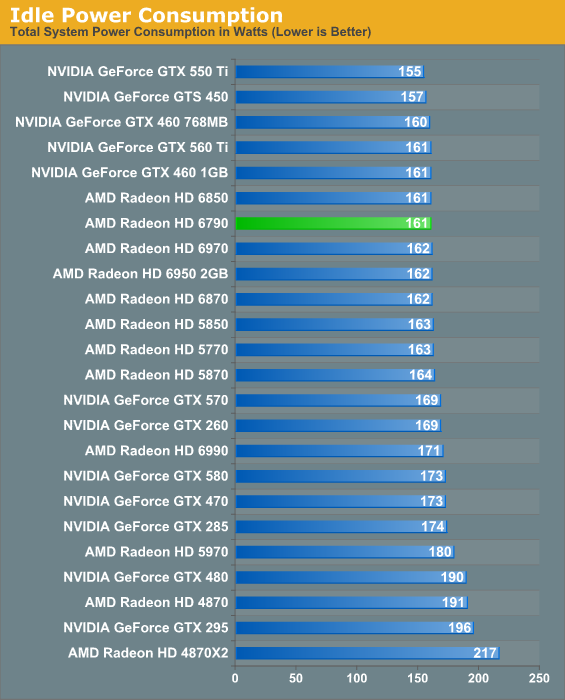
Idle power consumption rarely changes among the different tiers of a GPU, so the fact that the 6790 pulls almost as much power at idle as the 6800 series should not come as a surprise. It does end up being worse than the GTX 550 Ti, but almost exactly alike the GTX 460.

Given AMD’s TDP numbers, we were expecting our power results to closely shadow our 6870 results. Instead we had a pleasant surprise: power consumption under Crysis is higher than the 6850, but not significantly so. In fact it’s still below the GTX 550 Ti even though it significantly outperforms said video card on this game, and even compared to the 5770 it’s not significantly worse for the 6790’s performance advantage. Not that it’s great to be consuming more power than a 6850 for less performance, but it could very well have been worse.
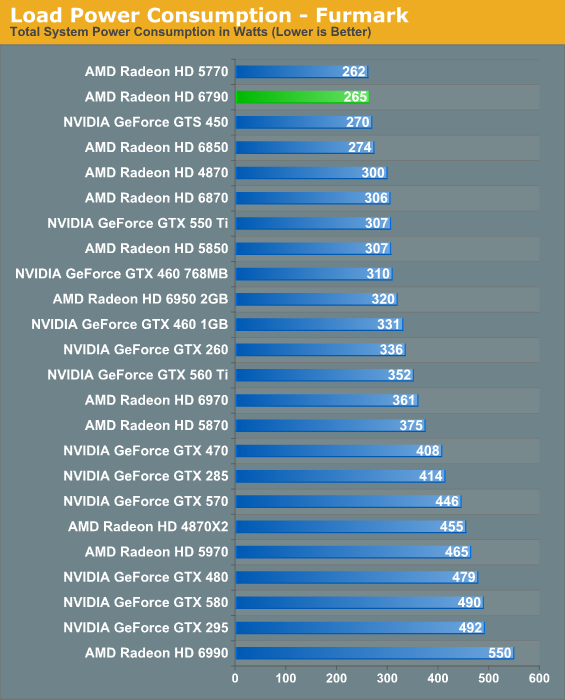
The situation under Furmark is even better surprisingly enough. The 6790 consumes less power than the 6850 here – not a ton less, but less. Perhaps more surprising is that compared to the 5770 it’s only consuming 3W more; this Barts chip may have a lot of functional units disabled, but that’s still quite remarkable, and is all the more proof of the optimizations AMD made for Barts compared to Cypress. This also makes it look exceptionally good versus the GTX 550 Ti and GTX 460 768MB, as it’s consuming 40-45W less.
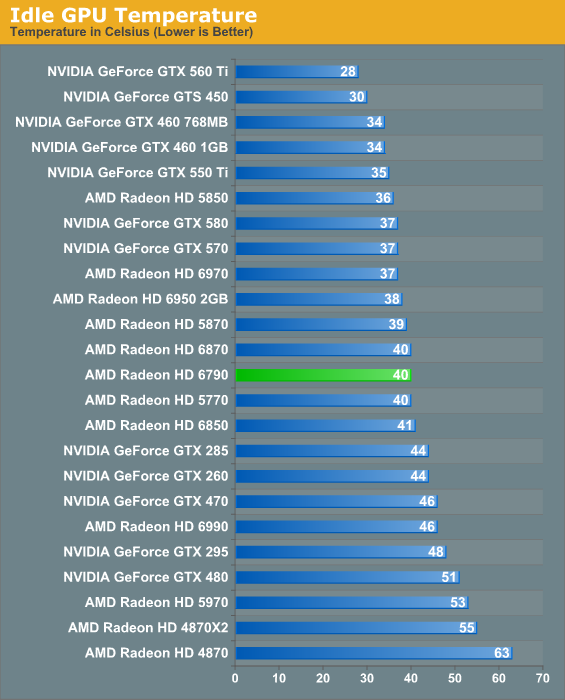
With idle power consumption being identical to the 6800 series and using the same cooler, the idle temperature is similarly close.
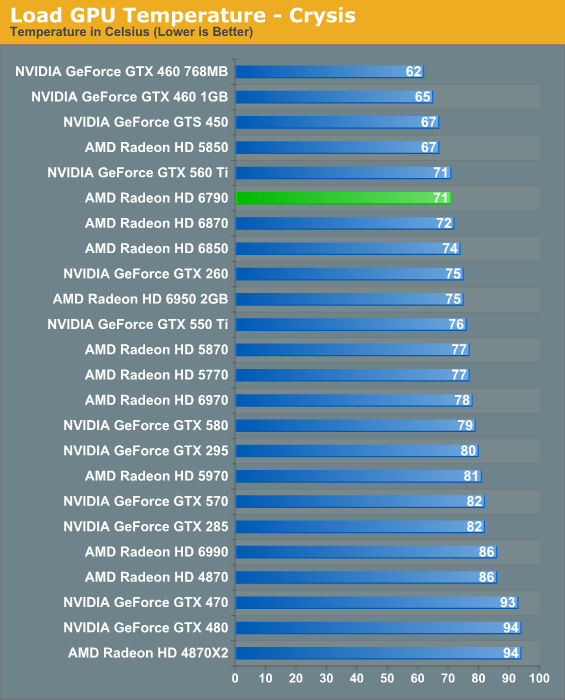
Given the power numbers we saw earlier, the 6870’s cooler ends up being overkill for the 6790. As a result Crysis temperatures are quite low, although the fully exhausting cooler can’t keep up with the open cooler of the GTX 460. Then again our 5770 is an open cooler, and it’s still much warmer. Keep in mind that this is going to highly vary with the design of the cooler the partner uses though.
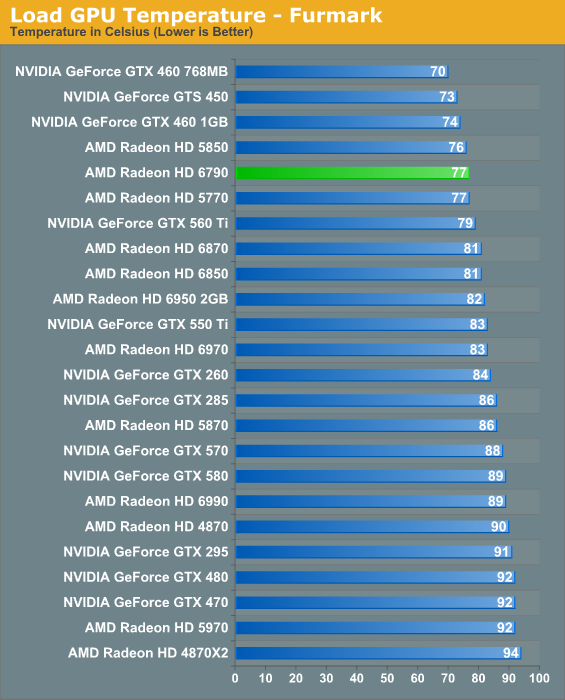
Temperatures under Furmark closely trend Crysis. An open cooler might be able to get the 6790 down to the low 70s.
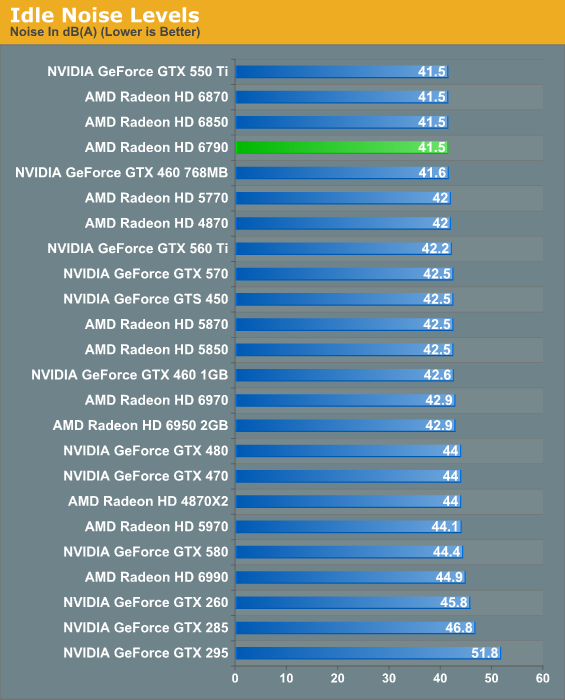
Idle noise is identical to the 6800 series, as we’d expect.
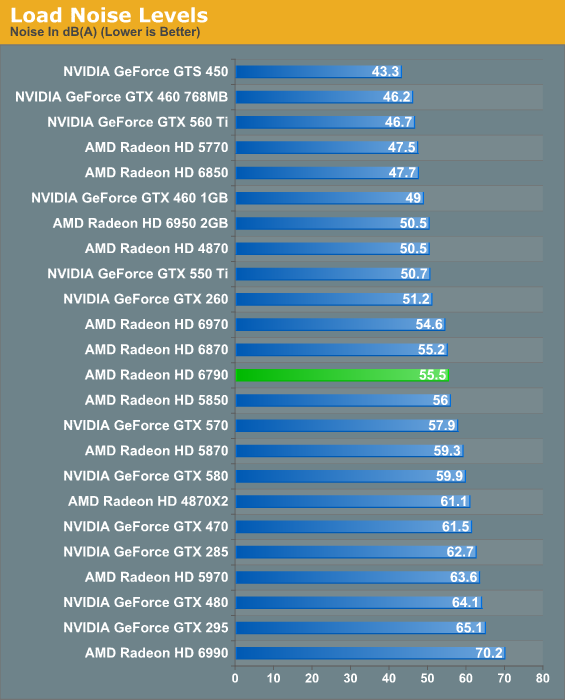
Load noise is where the wheels begin to fall off on our 6790 sample. The card does so well with regards to power consumption and temperature, but noise is just as bad as the 6870. This undoubtedly is due to how AMD tweaked the 6790 engineering sample – which is to say it likely hasn’t been optimized much if at all since it won’t go into production. Given the power data we’ve seen the 6790 doesn’t need to be much louder than a 6850, so hopefully partner cards will reflect this. If not, the worst case scenario may very well be having all the noise of a 6870 and not nearly the performance.










69 Comments
View All Comments
SquattingDog - Tuesday, April 5, 2011 - link
"it's LEANING from the past..." should be it's LEARNING from the past. Otherwise a great article, very speedily put out. Looks to be an interesting card, depending on what pricing it is available at here. Of course the 6850/6870 are much better and the 6850 looks to be better bang for buck, but when people cannot squeeze a few extra bucks out of the wallet, it should be pretty reasonable. Especially once the GTX460s are out of circulation, which is bound to happen soon enough.Glad to see more competition and finally some products reaching further down in the retail sector not just OEM from AMD.
ZL1Corvette - Tuesday, April 5, 2011 - link
2nd to last page possible typo:"Last but not least as always is our look at the power consumption, temperatures, and acoustics of the GTX 550 Ti."
Did you mean 6970?
ZL1Corvette - Tuesday, April 5, 2011 - link
See, we all make mistakes. I meant 6790.stm1185 - Tuesday, April 5, 2011 - link
800 Stream Procs, 40 Texture Units, 16 ROPs, 256 bit memory bus. Only the 6970 has a 840mhz clock compared to 750 mhz, and 1050mhz on the memory compared to 900mhz on the 4870.My card has held up well it seems.
james.jwb - Tuesday, April 5, 2011 - link
I have a 4890 with a 2560x1440 screen, and to my surprise, i can play quite a few games at 30fps, and most older ones at 60+fps. Like F1 2010, around 50fps.What a card, eh?
WhatsTheDifference - Tuesday, April 5, 2011 - link
hello. nice card. I play everything at 19x12 with my 4890 (in this case, an msi cyclone soc) with never a problem of any kind. it bloodies the 285's face.kind of a wondrous thing, then, that anandtech.com has banned the 4980 from all benchmarks...ain't it? XD
B3an - Wednesday, April 6, 2011 - link
*rolls eyes* ... They dont have any 2xx series here either. The ATI 4xxx and NV 2xx series do not belong here.If you want to see how your 4890 stacks up simply go the the GPU Bench page to compare.
WhatsTheDifference - Saturday, April 9, 2011 - link
what would you say these are, at least at first sight?NVIDIA GeForce GTX 295
NVIDIA GeForce GTX 285
NVIDIA GeForce GTX 260 Core 216
and
AMD Radeon HD 4870X2
AMD Radeon HD 4870
......?
please make your way to 'index' and 'the test'. or, maybe I'm confusing articles.
now adding the always-juvenile *rolls eyes*
pandemonium - Tuesday, April 5, 2011 - link
Gotta take the bad with that good though.Both the 4870 and 4870x2 run much hotter and take a butt load more power to produce lower framerates. And the 4870 was never a lower tier card by any means. Plus, no DX11 support on the 4870. Not that it's incredibly important, but just another note.
I'd say this is a good example of hardware evolution.
edpierce - Tuesday, April 5, 2011 - link
I disagree. Recent video card innovations have been real unimpressive lately. It really does seem like we are not much further than 3 years ago in terms of visual video card performance. Are we hitting a massive roadblock here?